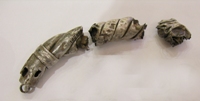Bracelet from the Caliphate Period

There are three surviving fragments of an ajorca, a silver bracelet that was part of a treasure trove found at Medina Elvira.
The remains found suggests that the piece was hollow, braided and had thin threads of filigree.
This type of jewellery could also be made out of gold and other metals and was used by the women of al-Andalus to adorn their wrists, arms or ankles.
Among the personal objects used by the people of al-Andalus, jewellery had a very special place for both men and women.
Jewels were carefully stored in boxes or chests and functioned not only as personal adornments, but also had social, ceremonial and even protective functions. They are little treasures that show the mastery of silversmiths who produced very elaborate pieces with great artistic inventiveness.
Next to the ajorca they found three coins issued under the emirate, an incomplete bronze foot, a ceramic oil-lamp and a circular handle. The findings at the archaeological site at Madinat Ilbira and its surrounding area led us to investigate further, using documentary, archaeological and iconographic sources, the applied arts of silversmiths from this initial Hispanomuslim period in the 8th and 9th Centuries, the Emirate and Caliphate until the last days of al-Andalus.
The group of objects found are related to other treasures, with the coins considered especially important as a means of dating the hoard.
Hours: Every Saturday of the month at 12 am
Lugar: Sala II, Museo de la Alhambra, Palacio Carlos V





 Contact
Contact




















